Discover the 16 Hidden Home Stressors You Need to Eliminate NOW (Guide)
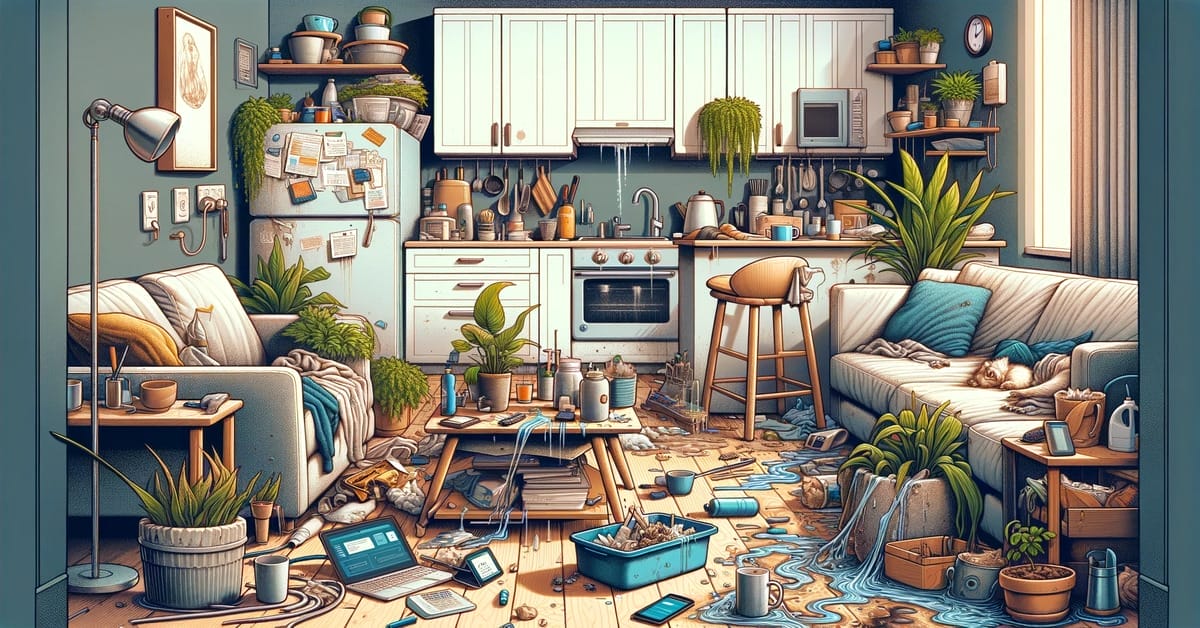
A home should be your personal retreat – a place to relax and break free from the day’s chaos. Keeping a tidy ship is my mantra because, let’s face it, mess equals stress. But beware, even the most spotless spaces can hide sneaky stress inducers.
Let’s uncover those hidden culprits in your castle, here’s what I will be covering:
- 📦 Clutter
- 💧 Dripping Faucets
- 🌱 Dying Houseplants
- 🛏️ An Unmade Bed
- 📑 Disorganized Documents
- 🧹 Dirt
- 🏆 Aspirational Items
- 🍳 A Disorganized Kitchen
- 👃 Unpleasant Odors
- 💡 Poor Lighting
- And more!
Let’s dive in!
1. Clutter
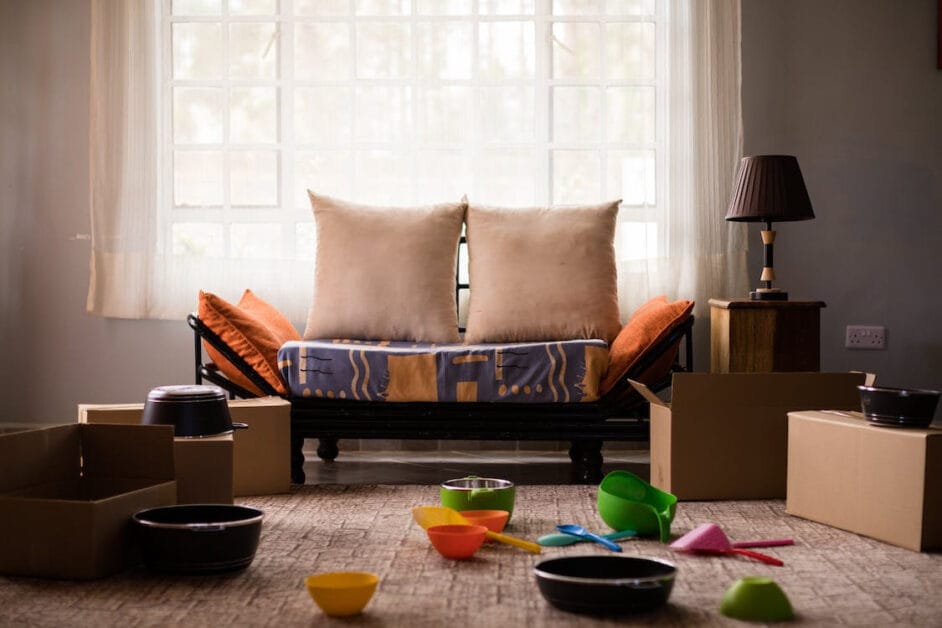
Studies have highlighted that a cluttered home can direct our well-being towards stress.
A 2010 study that caught my attention found a strong link between clutter and elevated cortisol levels in folks dealing with cluttered homes. The main reason? An abundance of unnecessary objects overstimulates our visual senses, making focusing trickier.
When surrounded by unnecessary objects, focusing and feeling calm is harder. That’s why I always recommend starting with a decluttering session.
Here are some tips on how to remove clutter:
- 🎯 Define Your Vision: Know what you want your space to look like.
- 🗂️ Sort by Category: Organize items by type, not by area.
- ⏱️ Decide Quickly: If unused for a year, donate or discard.
- ➕➖ New Rule: When something new comes in, something old goes out.
- 🧗 Go Vertical: Use walls for smart storage.
- 🧽 Keep Counters Clear: Designate spots for daily items.
- 🛋️ Smart Storage: Choose furniture that doubles as storage.
- 🏷️ Label: Mark bins to find things easily.
- ⏲️ Daily Declutter: Spend 15 minutes each day tidying up.
- 🌟 Consistent Look: Use matching containers for a neat appearance.
Interestingly, societal expectations have an additional role here. Have you ever thought about the ideal middle-class home representation? It’s always pictured as tidy.
Get rid of anything you don’t need and develop a strategy to maintain a minimalist space where everything has a place. Trust me, it’s worth it.
2. Dripping Faucets

Dripping Faucets are more of a menace than you would think.
It’s not just the water wastage; it’s the mental torture that comes with the incessant drippings. Popping sounds in the dead of the night can be enough to drive me crazy. It’s an easy enough problem to fix, I assure you.
The most common cause of a dripping faucet is a worn-out cartridge. To fix it. First, turn off the water supply. Next, remove the faucet handle and then the cartridge. Replace the old cartridge with a new one and put the handle back on. Finally, turn the water supply back on and run the water to ensure the problem is fixed.
It’s important to remember that decluttering or fixing a dripping faucet isn’t just another boring task. It’s an effective mindfulness practice.
One study showed that students who washed dishes were more mindful and experienced positive moods. So next time, don’t groan about a broken faucet. Look at it as a chance to practice mindfulness.
3. Dying Houseplants
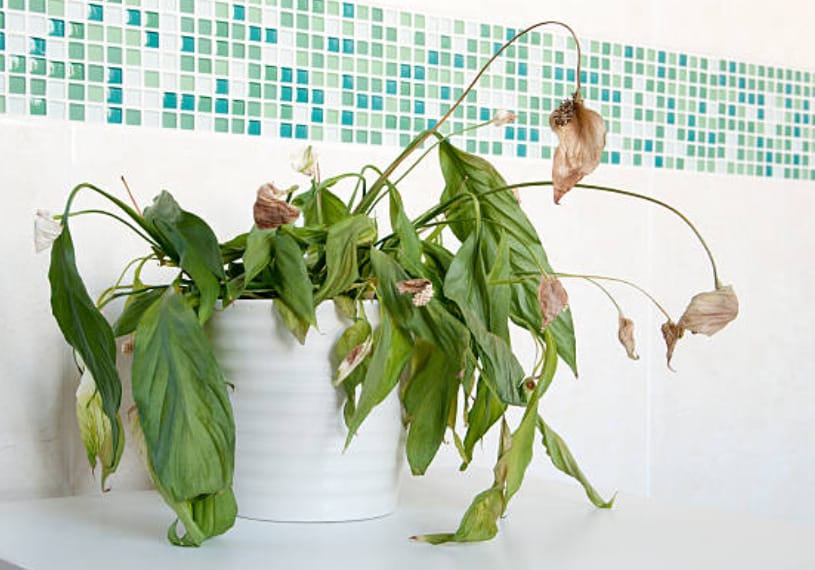
Isn’t it disappointing to see your once vibrant houseplant wilting away? Neglected plants can be downright deflating, not to mention they reportedly drain energy from space – bad news for those mindful of feng shui.
To revitalize your plants, you can try to do the following:
- 💧 Watering: Adjust watering habits for proper soil moisture
- ☀️ Lighting: Ensure adequate light and avoid harsh sun.
- ✂️ Pruning: Prune dead or yellowing leaves to redirect energy
- 🐛 Pests/Disease: Check for pests or diseases and treat them accordingly
- 🌱 Fertilizing: Fertilize sparingly with appropriate plant food
- 🪴 Repotting: Repot if necessary to provide adequate room for growth
- 💦 Humidity: Increase humidity through misting or a humidifier if needed
- 🌡️ Temperature: Maintain a consistent temperature without drastic changes
Sometimes, despite all efforts, a plant is too far gone, and it’s time to let go. It may sting to send a plant to its composting end, but a fresh new one can fill that empty pot and your heart while pumping your indoor spaces with a natural calm.
4. An Unmade Bed
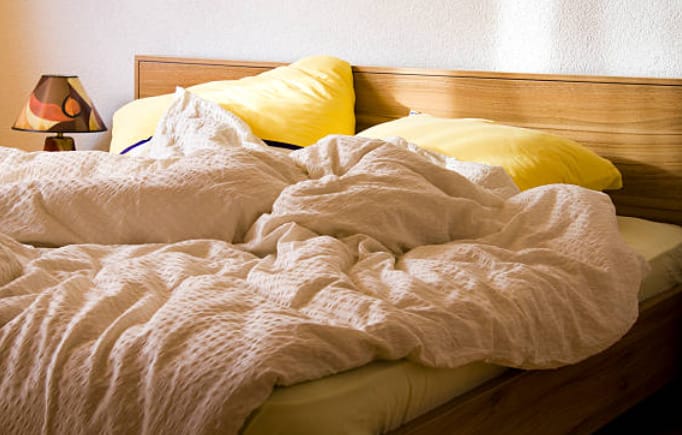
I used to be one of those people who couldn’t bring themselves to make their bed every day. But after reading about the benefits of a made bed, I decided to try it.
According to a survey by Sleepopolis, people who make their beds every day are more likely to wake up earlier, skip the snooze button, and feel more confident. Plus, a made bed can make you happier!
I make my bed every morning as part of my daily routine. It sets the tone for a relaxing night’s sleep and helps me start my day on the right foot.
If you’re like me and struggle with making your bed, try incorporating it into your daily routine and see if it affects your mood. Who knows, you might just become a bed-making convert like me!
5. Disorganized Documents

You know, Disorganized Documents could be a significant hidden stressor in your home. It’s time to take control and rid your sanctuary of this chaotic element.
It’s not just about eliminating clutter but also managing those knotty administrative tasks that, left unchecked, can silently contribute to your stress levels.
To avoid this, here are some tips that I have compiled:
- 📂 Sort: Categorize your documents by type.
- 🔥 Purge: Shred or recycle unnecessary papers.
- 💾 Digital: Scan and store documents electronically.
- 🏷️ Label: Clearly label all files and folders.
- 👀 Review: Weekly checks to prevent pile-ups.
- 📚 System: Choose a filing system that suits you.
- 📬 Immediate: Deal with mail right away.
- 🔄 Maintenance: Stick to your organization routine daily.
When you establish a system that keeps household items in their place, you’ll avoid the nuisance of continuously searching for them. It’s about cultivating a sense of control and being the master of your living space, which could lead to a notable decrease in stress.
6. Dirt
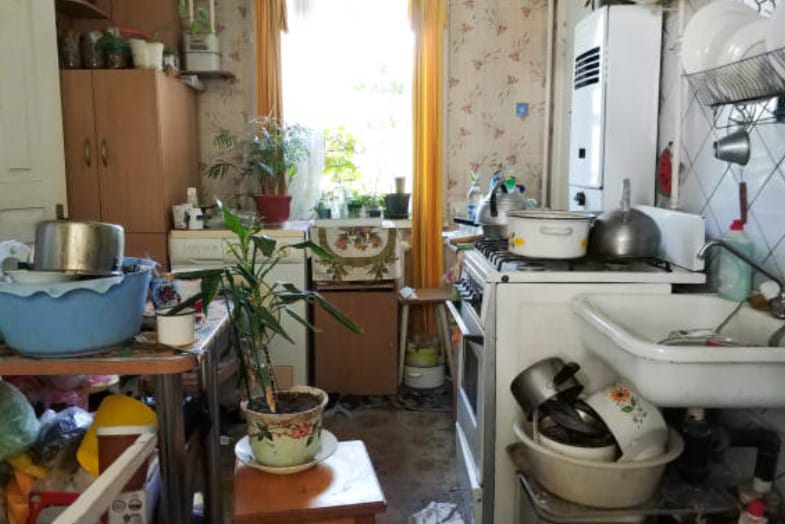
Have you ever noticed how a messy room seems to drain your energy? Mounds of dust and grime can turn your peaceful sanctuary into a stressful environment.
Homes riddled with dust bunnies, smudged mirrors, and dirty countertops are far from ideal retreats. A fleeting thought might be to ignore it. But deep down, we know it’s one of those nagging issues we can’t overlook forever.
Dive into these crisp categories and keep your place in top-notch condition—no fuss, just a straightforward, clean living plan.
| Frequency | Task |
|---|---|
| Daily | 🧹 Sweep/vacuum floors |
| Weekly | 🧽 Mop floors 🪶 Dust surfaces 🚽 Clean bathrooms 🛏️ Wash bedding |
| Monthly | 🧼 Deep clean appliances 🌬️ Wash curtains 🪟 Clean windows 🔧 Replace/clean air filters |
| Yearly | 🏠 Deep house cleaning 🍂 Clear gutters 🔍 Inspect home for repairs/maintenance |
If you find cleaning every day overwhelming, consider hiring a professional to do a weekly or monthly deep cleaning of your space. Trust me, it’s worth the investment.
The state of your home mirrors your state of mind. Whether it’s a leaning tower of unsorted mail or a kitchen sink full of dishes, every little clutter chips away at your peace, prioritize cleanliness and order in your living space. You’d be surprised at the ounce of serenity it brings.
7. Aspirational Items
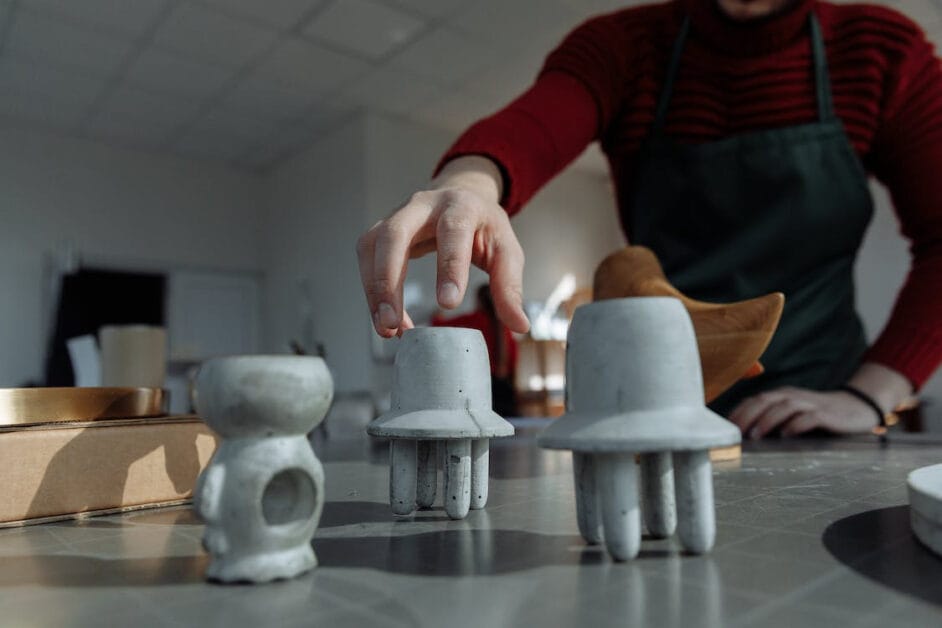
Ah, those aspirational items. Unused things act as silent stressors —like a dusty treadmill you thought you’d use every day or that guitar you only strummed twice.
How about those skinny jeans you’ve been hanging onto? Every time you see these items, you might feel a twinge of guilt and disappointment. Why? They remind you of things you wanted to do but didn’t.
Seeing these things every day made me feel guilty and unaccomplished. So, I decided to sell or donate them. Now, my home is filled with things that I use and enjoy.
Don’t let aspirational items bring you down. Let them go and make room for things that spark joy.
8. A Disorganized Kitchen
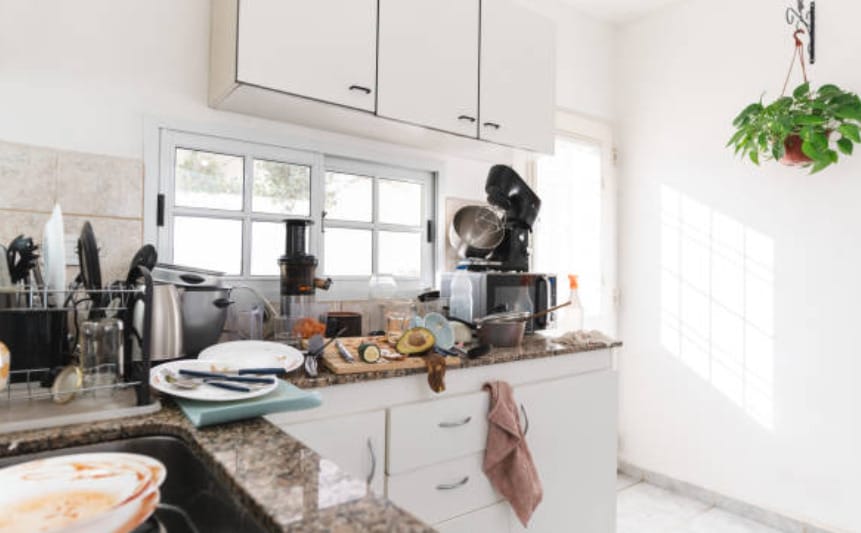
Have you ever tried whipping up a culinary masterpiece only to realize you can’t find that one vital tool? Kitchen disorganization can turn your peaceful cooking routine into an instant pressure cooker scenario!
Having your utensils, cookware, and tools stuffed haphazardly into drawers and cabinets can elevate those stress levels quickly.
Embrace these tricks and watch as your kitchen turns into the heart of the home, where function and form coexist beautifully. Here’s how to whip your kitchen into shape:
- 🔨 Designate Zones: Set up specific prep, cooking, and cleaning areas to streamline your kitchen’s flow. Keep your tools and ingredients within arm’s reach where they’re used most.
- 🧽 Clear Counters: Adopt the “less is more” mantra for counter space. Keep it sparse, housing only the essentials. This makes it easier to clean.
- 🗄️ Maximize Storage: Utilize vertical space with shelving, and consider pull-out drawers for deep cabinets. Use dividers for utensils and stackable bins for pantry goods.
- 🏷️ Decant & Label: Transfer bulk items into clear, labeled containers for a uniform look and easy inventory tracking.
- 🌙 Daily Reset: Make it a habit to do a quick sweep each night—dishes washed, surfaces wiped, and everything back in place.
- ♻️ Regular Purge: Schedule a monthly review of your pantry and fridge. Discard expired goods and unused items, making space for the new.
Consistency is also key when it comes to kitchen organization. This will help you develop a routine and ensure that you always know where everything is.
9. Unpleasant Odors

Let’s dive into a less-than-pleasant topic: Unpleasant Odors. They’re surprisingly good at sliding into our homes unnoticed, building up over time, and becoming a source of everyday stress.
Whether it’s spoiled food in the fridge or the trash can that needs emptying, combating these odors can be straightforward if you keep on top of things.
Keep your home smelling fresh and inviting with these simple and effective tips to eliminate unwanted odors.
- 🌬️ Ventilation is Key: Crack those windows and let exhaust fans work magic.
- 🧼 Regular Cleaning: Wipe, scrub, and take out the trash before it starts to sing.
- 🥣 Natural Absorbers: Bowls of baking soda, vinegar, or coffee grounds can be your scent saviors.
- 🍊 Fresh Scents: Simmer citrus peels and cinnamon, or use that trendy essential oil diffuser.
- 💨 Deodorize Soft Surfaces: Baking soda on the carpet? Yes, please. Vacuum after a brief chat.
- 🔧 Filter Check: Fresh filters mean fresh air—swap them out regularly.
- 🐾 Attentive Pet Care: Clean those pet hangouts unless you enjoy Eau de ‘wet dog.’
So, think about it. Are ‘odors’ and ‘clutter’ tucked away in your home positively contributing to stress? Let’s commit to sorting this out and see its effects on our daily stress.
Remember, a little effort goes a long way in creating a pleasant and inviting home environment.
10. Poor Lighting
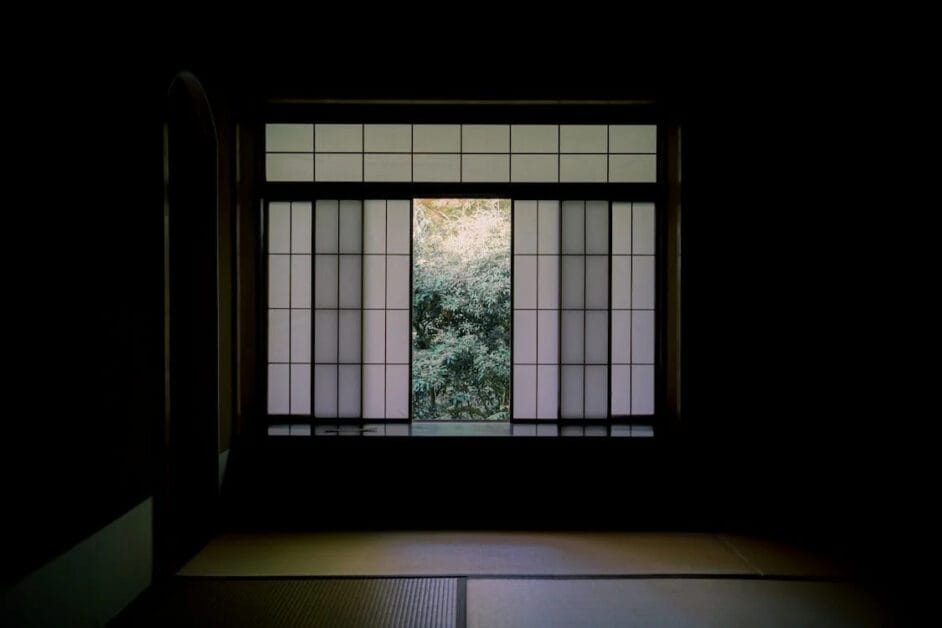
Now let me tell you, lighting in your house isn’t just a matter of aesthetics. It’s much more crucial, impacting our mood, stress levels, and productivity.
Sadly, our homes don’t always have access to abundant natural light, which can be a source of stress. Natural light’s important, folks! You can create a well-lit atmosphere by combining ambient overhead lighting with accent lights, giving you a snug effect.
Light up your life! Here’s how to chase away the shadows and bring brightness to every corner:
- 🌟 Layer Your Lighting: Mix different light sources for a versatile space.
- 🌞 Maximize Natural Light: Clear the way for sunshine to stream in.
- 🔍 Reflective Surfaces: Use mirrors to reflect and amplify light.
- 💡 Light Bulb Choice: Go for LEDs that resemble daylight.
- 🛋️ Lampshades Matter: Pick shades that let more light through.
- 📍 Strategic Lamp Placement: Set lamps to brighten dark nooks.
- 🎚️ Dimmer Switches: Get dimmers for adjustable light levels.
- 🎨 Color Palette: Paint with light hues for better light reflection.
- ✨ Regular Maintenance: Clean fixtures to keep them shining bright.
Remember, a well-lit space can make all the difference in how we feel and function. So, let’s brighten up our homes and our lives!
11. Stress-Inducing Colors
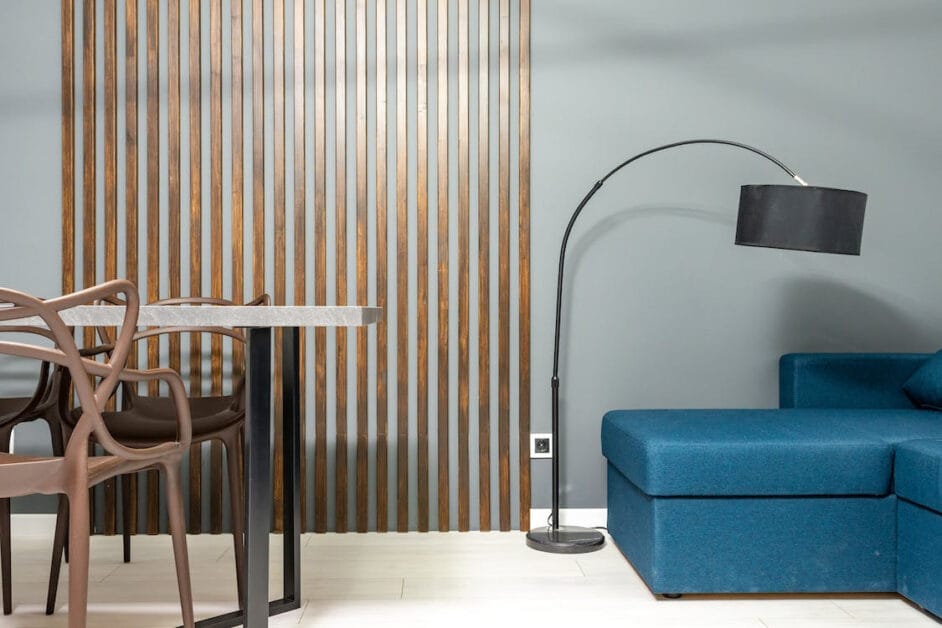
Ever consider that the colors in your living space might add to your stress levels? That zesty, energetic orange in your home office might be doing more than making a bold style statement – it could ramp up your anxiety.
Step into serenity with the right palette; it’s amazing how much the colors we choose for our walls can influence our mood and stress levels. Let’s turn your home into a calming retreat with some color wisdom.
- 🎨 Opt for Calming Hues: Choose colors known for their soothing effects, like blues, greens, and soft neutrals, to create a tranquil home environment.
- 🌈 Test Before You Paint: Use swatches or sample paint pots on your walls to see how the color behaves in different lighting throughout the day.
- 🖼️ Accents and Accessories: If you’re not ready for a big painting commitment, introduce calming colors through accents like pillows, rugs, or art.
- 🌟 Balance with Neutrals: Offset brighter shades with plenty of whites or greys to maintain a balanced, soothing color scheme.
- 🔄 Refresh Regularly: Keep your walls clean and touch up as needed to ensure the colors stay true and create a stress-reducing atmosphere.
Remember, the colors you surround yourself with profoundly impact your mood and stress levels, so choose shades that bring you peace and comfort.
12. Tech in Your Bedroom

Did you know having technology in your bedroom is one of my top hidden home stressors to eliminate? Let me share why with you:
The bedroom, dear readers, should be your ultimate haven for relaxation and rest. Picture your bedroom as a sanctuary, a personally optimized environment for releasing everyday life’s hustle and bustle stresses.
The Sleep Foundation uncovers that screens before bedtime suppress our body’s production of the sleep-inducing hormone melatonin. Remember, folks – interacting with your tech devices right before bed could significantly impact your sleep.
So, I suggest leaving your electronics in another room and picking up a good book instead. Trust me, it’ll help you unwind and get into the right mindset for a good night’s sleep.
Here are some other tips to optimize your bedroom for relaxation:
- 🌿 Soothing Colors: Opt for a calming color palette that promotes tranquility.
- 🛏️ Comfort is Key: Invest in a high-quality mattress and plush bedding.
- 🔇 Control the Sound: Use rugs and curtains to dampen outside noise.
- 🌡️ Cool and Fresh: Clean the bedroom with proper ventilation or a fan.
- 📦 Declutter: A tidy space equals a peaceful mind.
- 🖼️ Minimalist Decor: Choose simple, uncluttered decorations.
- 🌙 Lighting: Soft, warm lights or dimmers to wind down in the evenings.
- 🌬️ Aroma Therapy: Use scents like lavender to encourage relaxation.
- 🧘 Personal Retreat: Include a cozy corner for reading or meditating.
Remember, your bedroom should be a sanctuary for relaxation and rest. So, let’s keep the tech out and create a peaceful environment for a good night’s sleep.
13. Noise Pollution

When we’re talking home relaxation, silence isn’t simply golden – sometimes it’s necessary—Have you ever been irritated by an insistent neighbor mowing their lawn at sunrise?
As someone who values a peaceful home, noise pollution can be a major stressor. The World Health Organization recognizes the negative impact of noise pollution on our well-being.
Whether it’s traffic, construction, or noisy neighbors, there are ways to regain control of your home’s soundscape. Here are some straightforward strategies to achieve a quieter living space:
- 🔇 Rugs and Carpets: Lay down thick rugs or carpets to absorb sound.
- 🚪 Door Seals: Install weather stripping or draft stoppers on doors to block external noise.
- 🌳 Landscaping: Use plants and shrubs as a natural barrier to outdoor noise.
- 🖼️ Soundproof Windows: Invest in double-pane or soundproof windows.
- 🔨 Wall Insulation: Enhance wall insulation to dampen sound transmission.
- 🛠️ Acoustic Panels: Mount acoustic panels or foam on walls to absorb sound.
- 🔽 Ceiling Treatments: Use acoustic tiles or a dropped ceiling to reduce noise.
- 📦 Bookshelves: Fill bookshelves with books and décor to act as sound barriers.
- 🚫 Quiet Appliances: Choose low decibel ratings to reduce background noise.
- 🔌 Electrical Outlets: Seal gaps around electrical outlets to prevent sound leaks.
- 🍃 White Noise: Fans, air purifiers, or white noise machines mask unwanted sounds.
Don’t let noise pollution rob you of your peace and quiet. Take action to reclaim your home’s tranquility.
14. Your Work

As more of us work from home, our homes have taken on a new role as our offices. This shift can be both a blessing and a curse. It’s fantastic to skip the daunting commute and spend more time with our family.
But on the flip side, our relaxation hub has blurred into our production space. Workplace Mental Health points out the importance of our home’s dual role and shows us that we must establish boundaries.
Let’s dive into some practical tips to help create a space conducive to work yet respectful of your home life.
- 🚪 Designate a Workspace: Pick a spot in your home that is exclusively for work. This physical boundary helps your brain switch into ‘work mode’ and out of it when you’re done.
- 🕒 Set Clear Work Hours: Just like in an office, define your start and finish times. Communicate these to your household to respect your work-life balance.
- 🛑 Limit Distractions: Inform everyone at home of your work hours. Use signs or signals to minimize interruptions during critical work times.
- 📵 Tech Hygiene: Set boundaries for tech use. Turn off work notifications post-work hours to avoid the ‘always-on’ stress.
- 🌿 Take Real Breaks: Schedule breaks to step away from your workspace. It’s crucial for maintaining focus and avoiding burnout.
- 🗓️ Use a Planner: Organize your day with a planner. It’s a visual cue for you and others to understand your work structure.
- 👥 Communicate Expectations: Ensure everyone in your household understands and respects your work boundaries.
Whether by minimizing work in the home or mastering your go-to stress-relieving techniques, let’s ensure we’re giving our stress the attention it demands.
15. Mirrors
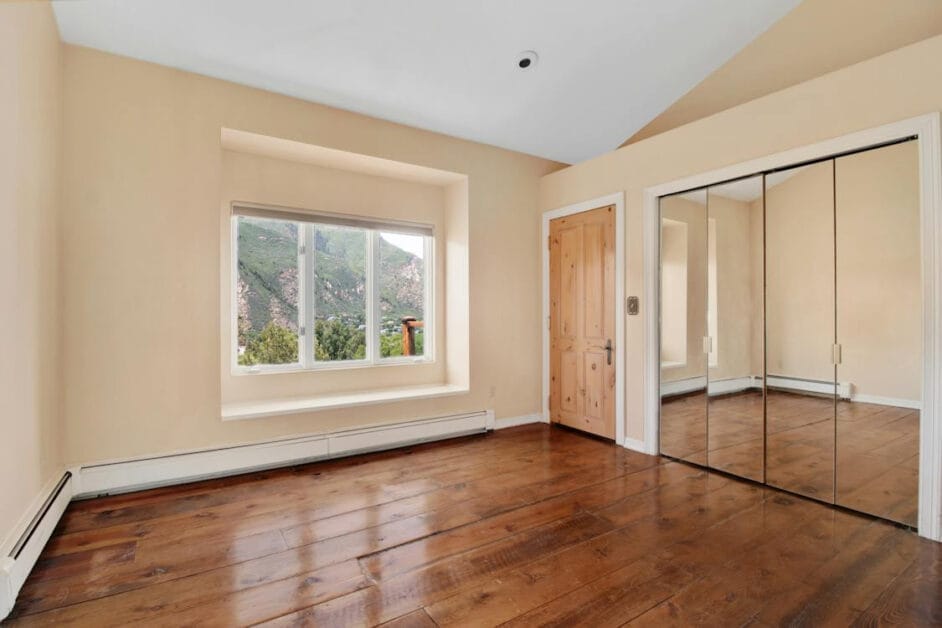
Who’d have thought mirrors could be a stress-inducing element in your homes? They certainly give a space the illusion of being larger, and well–obviously–they reflect.
And goodness knows I’m a fan of a well-placed mirror. But here’s an eye-opener: a report in the journal Behaviour Research and Therapy reveals that gazing into mirrors triggered stress and anxiety among their test subjects.
Crazy, right? Removing some of the mirrors from your home might be worth it if you’re feeling overwhelmed. Let’s focus on creating a stress-free environment!
16. Light Pollution

Getting enough sunlight is important for reducing stress, but did you know that excessive exposure to artificial light at night can have adverse effects?
According to National Geographic, increased light at night can reduce your body’s ability to produce melatonin, which can cause trouble sleeping, headaches, fatigue, stress, and anxiety.
To combat light pollution in your home and enhance your living environment, consider these effective strategies:
- 🛑 Blackout Curtains: Install blackout curtains to prevent external light intrusion.
- 🖼️ Window Films: Apply reflective or tinted window films that reduce incoming light.
- 🔧 Fixture Adjustment: Redirect your outdoor lighting fixtures downward to minimize skyglow.
- 💡 Dimmer Switches: Use dimmer switches to control the intensity of indoor lighting.
- 🌙 Motion Sensors: Equip outdoor lights with motion sensors to limit unnecessary illumination.
- 🕯️ Soft Lighting: Opt for lamps with soft, warm bulbs for a gentler light at night.
- 🛠️ Shielding: Add shields to outdoor lights to focus the light downwards.
- 📅 Timers: Set timers on outdoor lights to ensure they are only on when needed.
- 🌟 Star-Friendly Bulbs: Choose bulbs certified as “dark sky friendly” to reduce blue light emissions.
- 👁️ Light Zones: Create lighting zones in your home to use only the light you need, where you need it.
Remember, a good night’s sleep is crucial for a healthy lifestyle.
Stress-Proof Your Space: Maintenance Strategies for Lasting Serenity
Conquering home stressors is half the battle; keeping them at bay is where the real magic happens. Here’s how to maintain that stress-free sanctuary vibe:
- Regular Routines: Set up a cleaning and decluttering schedule that’s realistic. Keep it consistent, whether it’s 15 minutes a day or a couple of hours on the weekend.
- One In, One Out Rule: Whenever you bring a new item into your space, let go of another. This keeps clutter under control and ensures everything has its place.
- Mindful Purchasing: Before buying anything, ask yourself if it’s necessary or will add to the clutter. Sometimes, the best purchase is the one you don’t make.
- Daily Resets: Make it a habit to ‘reset’ each room before you leave it. A quick tidy-up can prevent messes from accumulating.
- Zone Cleaning: Break your home into zones and focus on one zone each week. This prevents any area from becoming overwhelming.
- Stress-Free Palette: Choose colors and décor that promote calmness and joy. When your environment reflects a peaceful vibe, it helps maintain a stress-reduced atmosphere.
- Tech-Free Zones: Designate areas in your home, like the bedroom, where technology is a no-go. This encourages relaxation and better sleep.
- Quality Over Quantity: Invest in quality items that last longer and you truly love, rather than filling your space with things that will only add to the chaos.
Implementing these practices ensures your home remains a stress-free zone long after the initial overhaul.
References
Studies:
- “The Dark Side of Home: Assessing possession ‘clutter’ on subjective well-being,” by Joseph Ferrari et al.
- “The Cost of Disorganization in the Workplace” by Brother International Corporation.
- “The Use of Technology in the Bedroom: Implications for Sleep” by the National Sleep Foundation.
Organizations:
- Alliance for Water Efficiency. http://allianceforwaterefficiency.org/
- American Cleaning Institute. http://cleaninginstitute.org/
- Illuminating Engineering Society (IES). https://www.ies.org/
Books:
- “How Not to Kill Your Houseplant” by Veronica Peerless. https://www.barnesandnoble.com/w/how-not-to-kill-your-houseplant-veronica-peerless/1125903793
- “Color Psychology and Color Therapy” by Faber Birren. https://www.abebooks.com/signed-first-edition/Color-Psychology-Therapy-Factual-Study-Influence/18896971991/bd
- “Mirror, Mirror: The Uses and Abuses of Self-Love” by Simon Blackburn. https://press.princeton.edu/books/hardcover/9780691161426/mirror-mirror
Website Resources:
- Sleep.org by the National Sleep Foundation. http://sleep.org/
- The Kitchn. http://thekitchn.com/
- International Dark-Sky Association. http://darksky.org/
